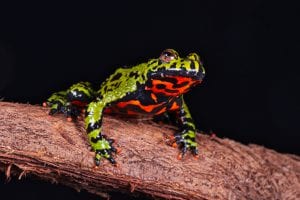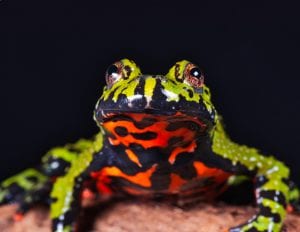The Oriental Fire Bellied toad occurs throughout Korea, North East China and into Russia. Geographically it varies in body colouration and intensity of the red belly. The belly is used to deter predators, this toad is mildly poisonous – the toad raises its arms, and flattens itself to show off the red belly when under threat. It is reported that they will flip themselves on their back under  extreme provocation – but I have never seen such an extreme display. The toxins are very mild, and only likely to (rarely cause skin / eye irritation). Like all Bombina species it lives in areas of shallow water marsh land.
extreme provocation – but I have never seen such an extreme display. The toxins are very mild, and only likely to (rarely cause skin / eye irritation). Like all Bombina species it lives in areas of shallow water marsh land.
We always advise the use of plastic or glass vivaria. Provide a shallow water area (around 15-20cm deep), many keepers provide two thirds  water and one third land. Hides can be provided on the land, and many keepers like to décor the land with live plants which creates a bio active natural terrarium. Always treat the water with a water conditioner such as ZooMed Reptisafe. The toads will spend large amounts of time floating on the surface of the water.
water and one third land. Hides can be provided on the land, and many keepers like to décor the land with live plants which creates a bio active natural terrarium. Always treat the water with a water conditioner such as ZooMed Reptisafe. The toads will spend large amounts of time floating on the surface of the water.
In the wild they eat a large amount of aquatic insects. However in captivity they will eat all commercial livefood. There is a downside to this, crickets and the like will drown in the water, and the supplement powders can be washed off. For this reason we always suggest feeding just enough for them to eat in a few minutes, and then remove the insects. Please do not purchase this species if feeding live insects concerns you at all. In your thought process keep in mind that it’s not unusual to have the odd cricket or other livefood to escape around the house. Also keep in  mind that the livefood will also need to be looked after to keep it alive and more nutritionally viable. There are specially designed holding tanks, and special food for the insects (typically this is called “gutloading”) – this also passes the goodness to the toads too. Always dust food every other day with a good quality supplement powder. Again, a debatable topic, and there are many varieties of supplements. We tend to use and recommend VetArk Nutribal.
mind that the livefood will also need to be looked after to keep it alive and more nutritionally viable. There are specially designed holding tanks, and special food for the insects (typically this is called “gutloading”) – this also passes the goodness to the toads too. Always dust food every other day with a good quality supplement powder. Again, a debatable topic, and there are many varieties of supplements. We tend to use and recommend VetArk Nutribal.
